Experimental Study of the Usability of Recycling Marble Waste as Aggregate for Road Construction
Abstract
:1. Introduction
2. Materials and Methods
2.1. Sampling of Marble Aggregate
- -
- First, marble wastes were crushed by a hammer.
- -
- A second crushing step was carried out using a crusher machine.
- -
- Finally, fine aggregate and coarse aggregate were obtained by a sieving step.
2.2. Tests Procedures
2.2.1. Chemical Analysis
2.2.2. Scanning Electron Microscope and X-ray-Diffraction
2.2.3. Hydration Temperature Measurement
2.2.4. Particle Size Analysis
2.2.5. Densities
2.2.6. Water Absorption Coefficient
2.2.7. Sand Equivalent Test
2.2.8. Micro-Deval Test
2.2.9. Los Angeles Test
2.2.10. Flakiness Index
2.2.11. Elongation Index
3. Results and Discussions
3.1. Tests Results
3.1.1. Chemical Composition
3.1.2. Microstructure Analysis
3.1.3. Particle size Distribution
3.1.4. Physical Properties
3.1.5. Resistance to Abrasion
3.1.6. Resistance to Fragmentation
3.1.7. Particles Shape
3.2. Requirements of Conventional Road Aggregates
- ✓
- Aggregates must have well graded and graduated granular distribution in order to minimize the voids content in the granular matrix of pavement layers.
- ✓
- Aggregates must have an acceptable resistance to crushing under submitted loads of traffic.
- ✓
- Aggregates must have an acceptable hardness. The hardness is the resistance both to abrasive actions between aggregate grains and between grains and tires.
- ✓
- Aggregates must have a reasonable soundness, which means that they have an acceptable resistance to weathering such as temperature variations, wind, and rainfall, etc.
- ✓
- Aggregates grain shape must be too rich of angular grains. This means that the percentage of rounded, flaky, or elongated grains must be very low.
- ✓
- Aggregates must have a sufficient toughness in order to have an acceptable resistance of aggregates to fracture.
- ✓
- Aggregate grains must be non-porous to avoid, as much as possible, water absorption.
- ✓
- Aggregates must have more affinity for bitumen in order to increase their bond.
- ✓
- Aggregates must be as economical as possible.
3.3. Discussions
3.4. Design of Marble AggregatesProduction Unit
- ➢
- Marble waste storage zone: The marble waste collected from marble manufactory are stored in this zone.
- ➢
- Crushing step: In this step, marble wastes are crushed into small grains.
- ➢
- Sieving step: In this step, the obtained grains is sieved into the different granular fractions.
- ➢
- Aggregates storage zone: This zone is reserved for storage of the different obtained aggregates.
4. Conclusions
- ➢
- Chemical analysis shows that the obtained marble aggregate is too rich in calcite;
- ➢
- Microstructure analysis, using XRD pattern and SEM image, shows that the tested marble does not have any hydraulic property in the presence of water and it can be considerate as an inert material;
- ➢
- Granular distribution of the marble aggregates is well graded and graduated, and they are composed of grains with different size ranges;
- ➢
- Bulk density and absolute density of marble aggregates are within the conventional ranges;
- ➢
- Fine marble aggregate is very proper, and it do not contain any clay fraction;
- ➢
- Coarse marble aggregate has an acceptable resistance both to abrasion actions and to fragmentation under different submitted loads;
- ➢
- The grain shape of the tested coarse marble aggregate makes it suitable for the construction of the different layers of roads.
Author Contributions
Funding
Institutional Review Board Statement
Informed Consent Statement
Data Availability Statement
Conflicts of Interest
References
- Gonfa, L.; Quezon, E.T.; Geremew, A. Experimental study on application of marble waste as conventional aggregate for base course materials. J. Civ. Eng. Sci. Technol. 2020, 11, 144–163. [Google Scholar] [CrossRef]
- Akinwumi, I.I.; Booth, C.A. Experimental insight s of using Waste Marble Fines to Modify the geotechnical properties of a Lateritic Soil. J. Environ. Eng. Landsc. Manag. 2015, 23, 121–128. [Google Scholar] [CrossRef]
- Esat, K.; Ince, A.R. A preliminary concrete mix design for SCC with marble powders. Constr. Build. Mater. 2009, 23, 1201–1210. [Google Scholar]
- Benjeddou, O.; Alyousef, R.; Mohammadhosseini, H.; Soussi, C.; Khadimallah, M.A.; Alabduljabbar, H.; TahiR, M.M. Utilisation of waste marble powder as low-cost cementing materials in the production of mortar. J. Build. Eng. 2020, 32, 101642. [Google Scholar] [CrossRef]
- Tuncan, M.; Tuncan, A.; Cetin, A. The use of waste materials in asphalt concrete mixtures. Waste Manag. Res. J. Sustain. Circ. Econ. 2003, 21, 83–92. [Google Scholar] [CrossRef]
- Chandra, S.; Ravi, A.; Abraham, K.B.; John, A. Utilization of industrial wastes in road construction: A review. J. Emerg. Technol. Innov. Res. 2019, 6, 197–201. [Google Scholar]
- Gupta, M.; Sharma, U. Feasibility study for using industrial waste as filler in bituminous concrete. J. Waste Manag. Dispos. 2019, 2, 201. [Google Scholar]
- Kara, A.; Karacasu, M. Use of Ceramic Wastes in Road Pavement Design. In Proceedings of the World Congress on New Technologies, Barcelona, Spain, 15–17 July 2015; p. 226. [Google Scholar]
- Ulubeyli, G.C.; Bilir, T.; Artir, R. Durability Properties of Concrete Produced by Marble Waste as Aggregate or Mineral Additives. Procedia Eng. 2016, 161, 543–548. [Google Scholar] [CrossRef] [Green Version]
- Haddadou, N.; Chaid, R.; Ghernouti, Y.; Adjou, N.; Bouzoualegh, M. Fresh and hardened properties of self-compacting concrete with different mineral additions and fibers. J. Build. Mater. Struct. 2015, 2, 41–50. [Google Scholar] [CrossRef]
- Alyousef, R.; Benjeddou, O.; Soussi, C.; Khadimallah, M.A.; Mohamed, A.M. Effects of Incorporation of Marble Powder Obtained by Recycling Waste Sludge and Limestone Powder on Rheology, Compressive Strength, and Durability of Self-Compacting. Concr. Adv. Mater. Sci. Eng. 2019, 2019, 4609353. [Google Scholar] [CrossRef] [Green Version]
- Alyousef, R.; Khadimallah, M.A.; Soussi, C.; Benjeddou, O.; Jedidi, M. Experimental and Theoretical Study of a New Technique for Mixing Self-Compacting Concrete with Marble Sludge Grout. Adv. Civ. Eng. 2018, 2018, 3283451. [Google Scholar] [CrossRef] [Green Version]
- Alyousef, R.; Benjeddou, O.; Khadimallah, M.A.; Mohamed, A.M.; Soussi, C. Study of the Effects of Marble Powder Amount on the Self-Compacting Concretes Properties by Microstructure Analysis on Cement-Marble Powder Pastes. Adv. Civ. Eng. 2018, 2018, 6018613. [Google Scholar] [CrossRef]
- Topçu, I.B.; Bilir, T.; Uygunoğlu, T. Effect of waste marble dust content as filler on properties of self-compacting concrete. Constr. Build. Mater. 2009, 23, 1947–1953. [Google Scholar] [CrossRef]
- Belaidi, A.S.E.; Azzouz, L.; Kadric, E.; Kenai, S. Effect of natural pozzolana and marble powder on the properties of self-compacting concrete. Constr. Build. Mater. 2012, 31, 251–257. [Google Scholar] [CrossRef]
- Sadek, D.M.; El-Attar, M.M.; Ali, H.A. Reusing of marble and granite powders in self-compacting concrete for sustainable development. J. Clean. Prod. 2016, 121, 19–32. [Google Scholar] [CrossRef]
- Gesoğlu, M.; Güneyisi, E.; Kocabağ, M.E.; Bayram, V.; Mermerdaş, K. Fresh and hardened characteristics of self compacting concretes made with combined use of marble powder, limestone filler, and fly ash. Constr. Build. Mater. 2012, 37, 160–170. [Google Scholar] [CrossRef]
- Uysal, M.; Yilmaz, K. Effect of mineral admixtures on properties of self-compacting concrete. Cem. Concr. Compos. 2011, 33, 771–776. [Google Scholar] [CrossRef]
- Uygunoğlu, T.; Topçu, I.B.; Çelik, A.G. Use of waste marble and recycled aggregates in self-compacting concrete for environmental sustainability. J. Clean. Prod. 2014, 84, 691–700. [Google Scholar] [CrossRef]
- Aruntaş, H.Y.; Gürü, M.; Dayı, M.; Tekin, İ. Utilization of waste marble dust as an additive in cement production. Mater. Des. 2010, 31, 4039–4042. [Google Scholar] [CrossRef]
- Rana, A.; Kalla, P.; Csetenyi, L. Sustainable use of marble slurry in concrete. J. Clean. Prod. 2015, 94, 304–311. [Google Scholar] [CrossRef]
- Sardinha, M.; de Brito, J.; Rodrigues, R. Durability properties of structural concrete containing very fine aggregates of marble sludge. Constr. Build. Mater. 2016, 119, 45–52. [Google Scholar] [CrossRef]
- Mashaly, O.; El-Kaliouby, B.A.; Shalaby, B.; El-Gohary, A.; Rashwan, M. Effects of marble sludge incorporation on the properties of cement composites and concrete paving blocks. J. Clean. Prod. 2016, 112, 731–741. [Google Scholar] [CrossRef]
- Bilgin, N.; Yeprem, H.A.; Arslan, S.; Bilgin, A.; Günay, E.; Marşoglu, M. Use of waste marble powder in brick industry. Constr. Build. Mater. 2012, 29, 449–457. [Google Scholar] [CrossRef]
- Alyousef, R.; Benjeddou, O.; Soussi, C.; Khadimallah, M.A.; Jedidi, M. Experimental Study of New Insulation Lightweight Concrete Block Floor Based on Perlite Aggregate, Natural Sand, and Sand Obtained from Marble Waste. Adv. Mater. Sci. Eng. 2019, 2019, 8160461. [Google Scholar] [CrossRef] [Green Version]
- Abdelkader, H.A.M.; Hussein, M.M.A.; Ye, H. Influence of Waste Marble Dust on the Improvement of Expansive Clay Soils. Adv. Civ. Eng. 2021, 2021, 3192122. [Google Scholar] [CrossRef]
- Terzi, S.; Karasahin, M. Use of marble dust for hot mix asphalt as a filler material. J. Technol. Chamb. Civ. Eng. 2003, 14, 2903–3022. [Google Scholar]
- Chandra, S.; Kumar, P.; Feyissa, B.A. Use of marble dust in road construction. Road Mater. Pavement Des. 2002, 3, 317–330. [Google Scholar] [CrossRef]
- Alkam, R.B.; Said, L.B.; Muin, S.A. Durability performance of asphalt concrete wearing course using marble waste as filler. J. East. Asia Soc. Transp. Stud. 2019, 13, 1571–1588. [Google Scholar]
- Kofteci, S.; Kockal, N.U. Using marble wastes as fine aggregate in hot mix asphalt production. Int. Civ. Struct. Eng. 2014, 1, 117–121. [Google Scholar]
- Zargar, M.B.; Gupta, R. A review paper on use of marble dust and furnace slag by replacing sand in pavement quality concrete of rigid pavement. Int. Res. J. Eng. Technol. 2018, 5, 865–867. [Google Scholar]
- Misra, A.K.; Mathur, R.; Rao, Y.V.; Singh, A.P.; Geol, P. A new technology of marble slurry waste utilization in roads. J. Sci. Ind. Res. 2010, 69, 67–72. [Google Scholar]
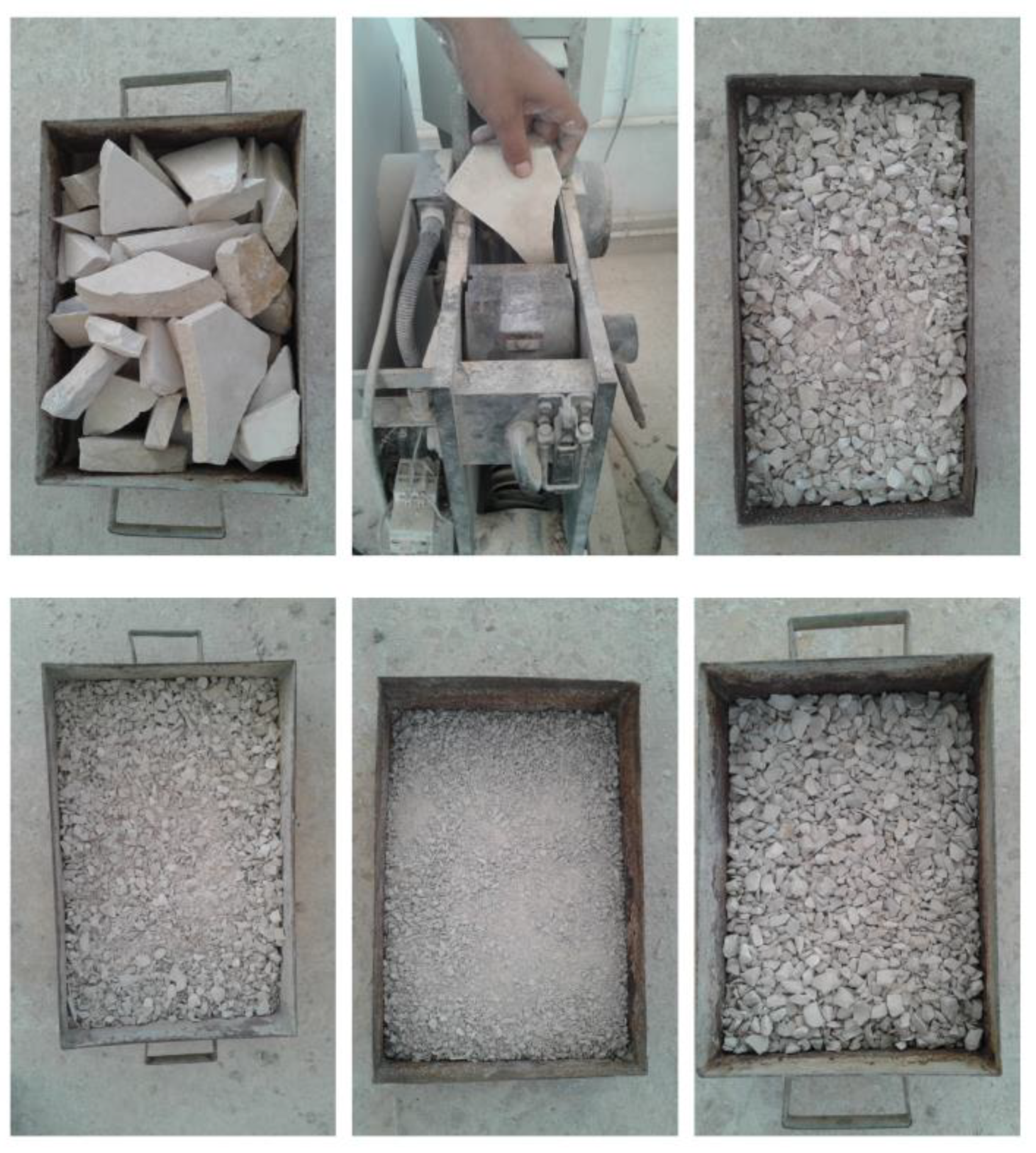
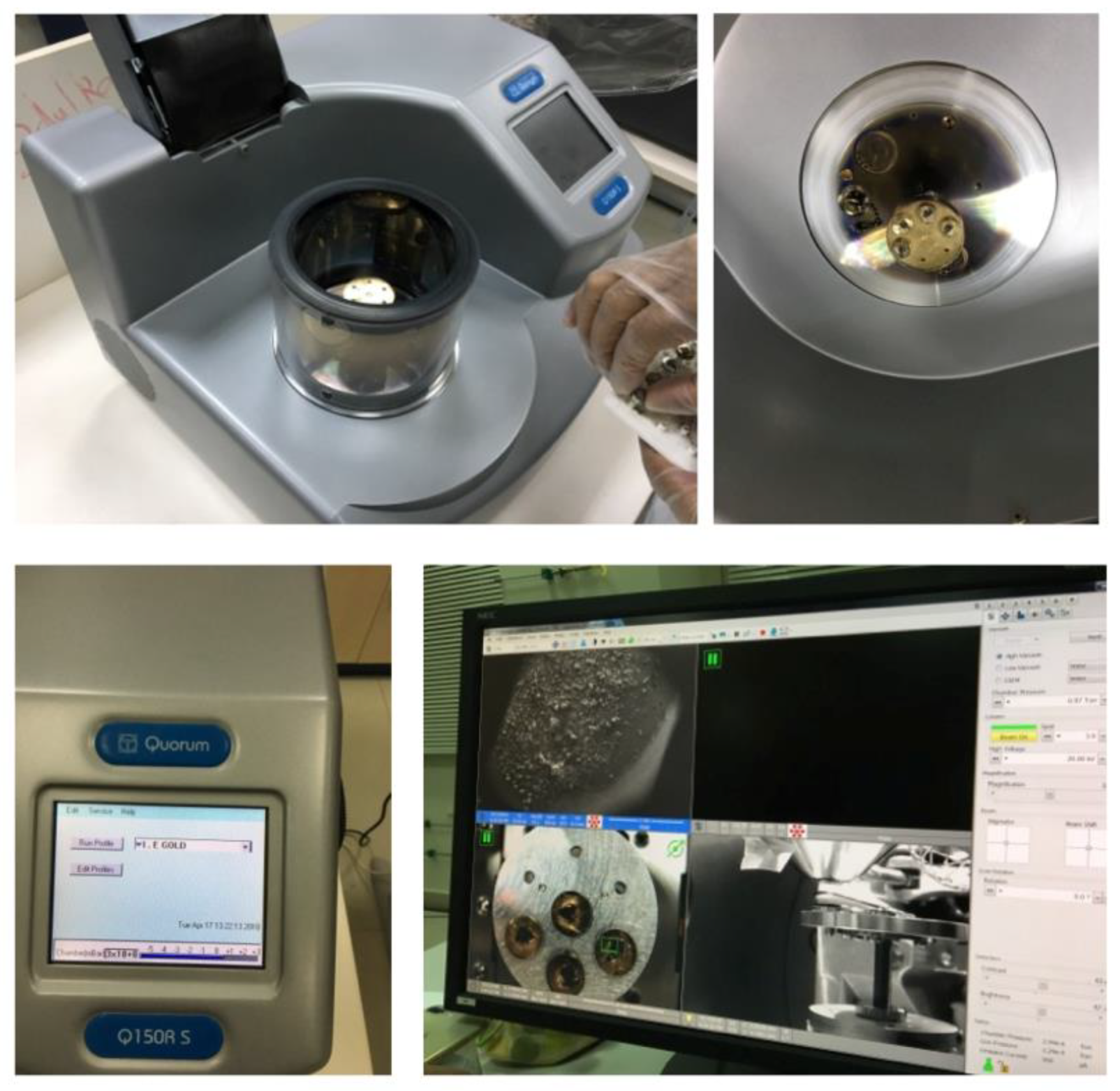
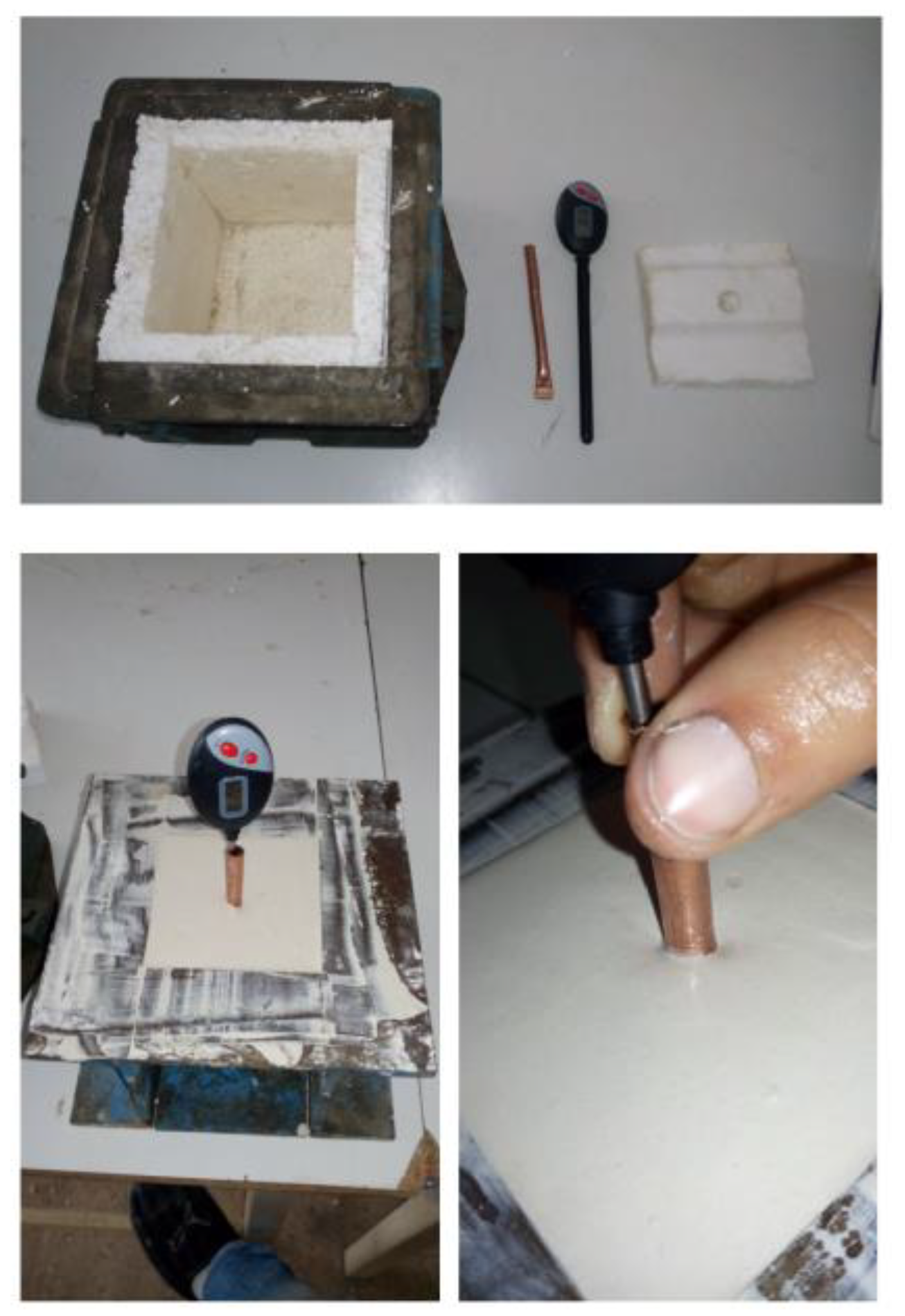
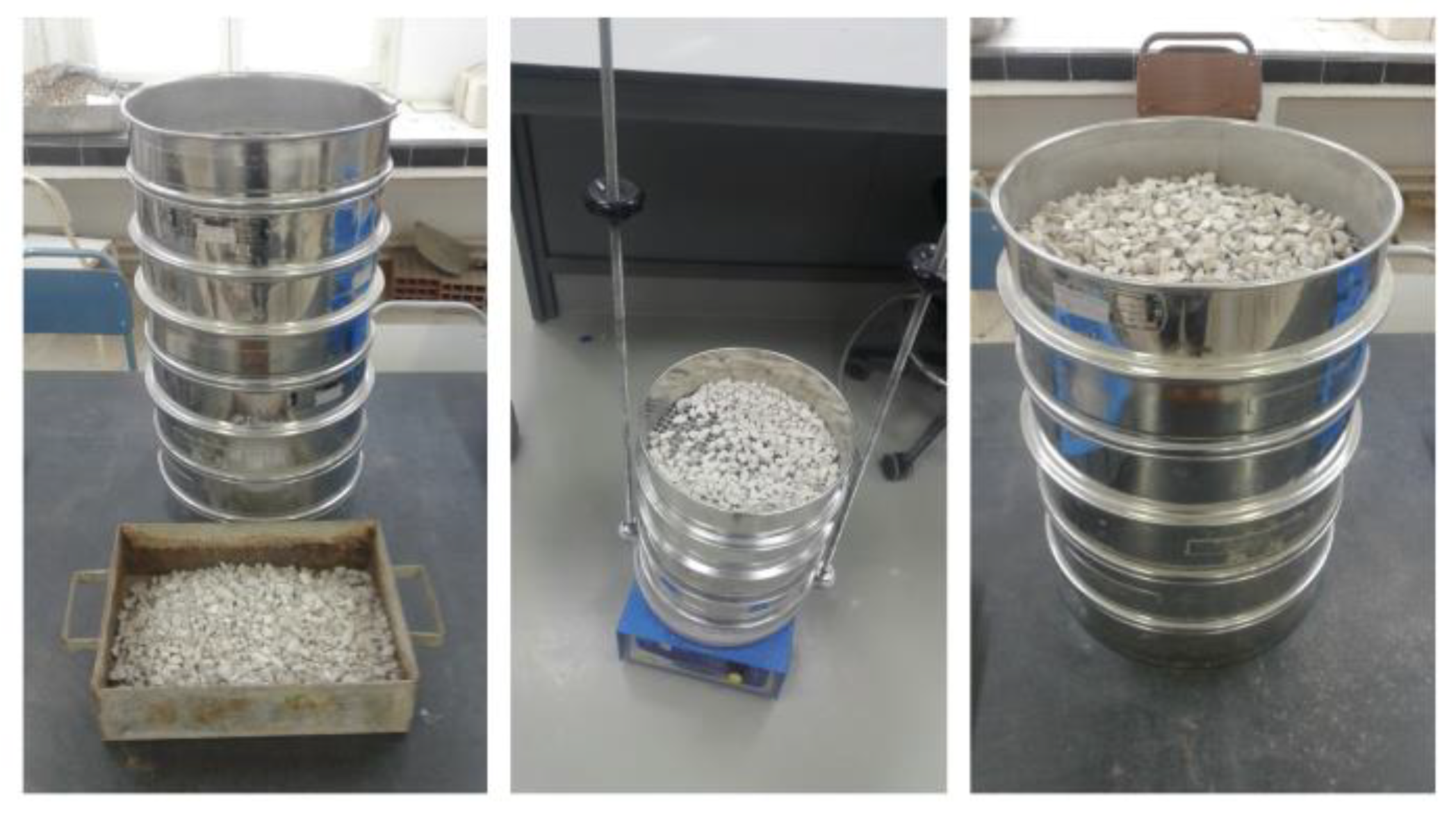
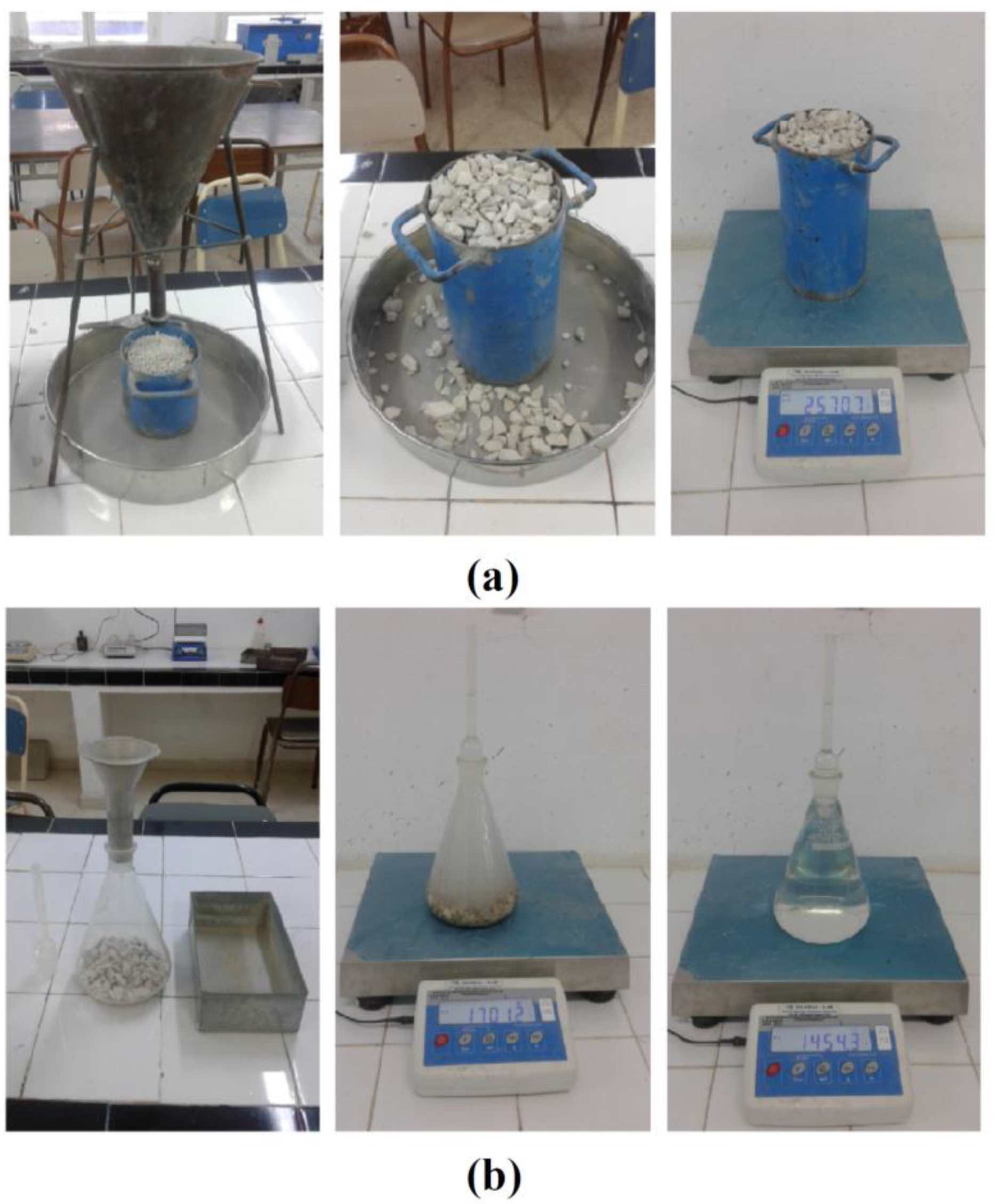
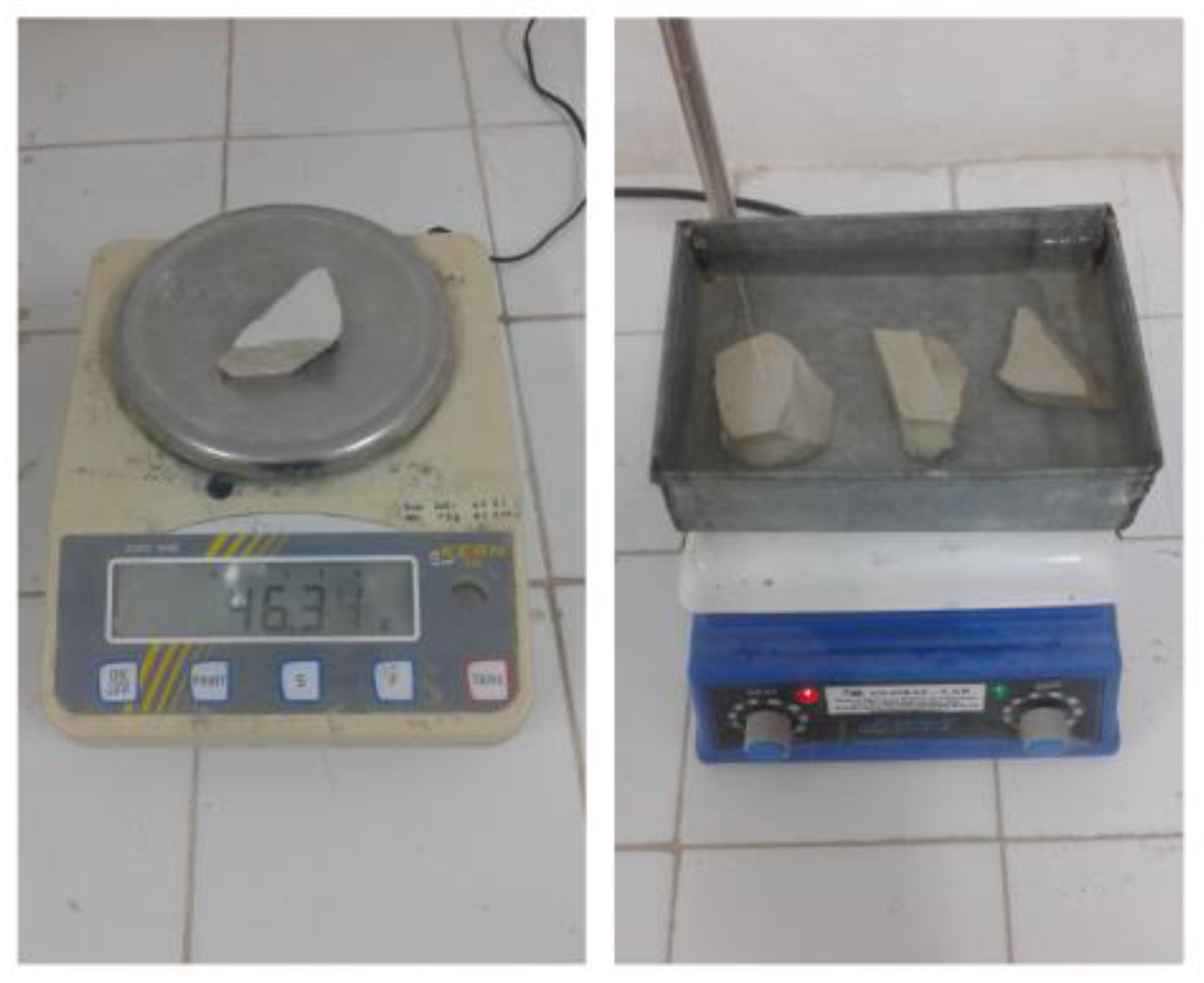
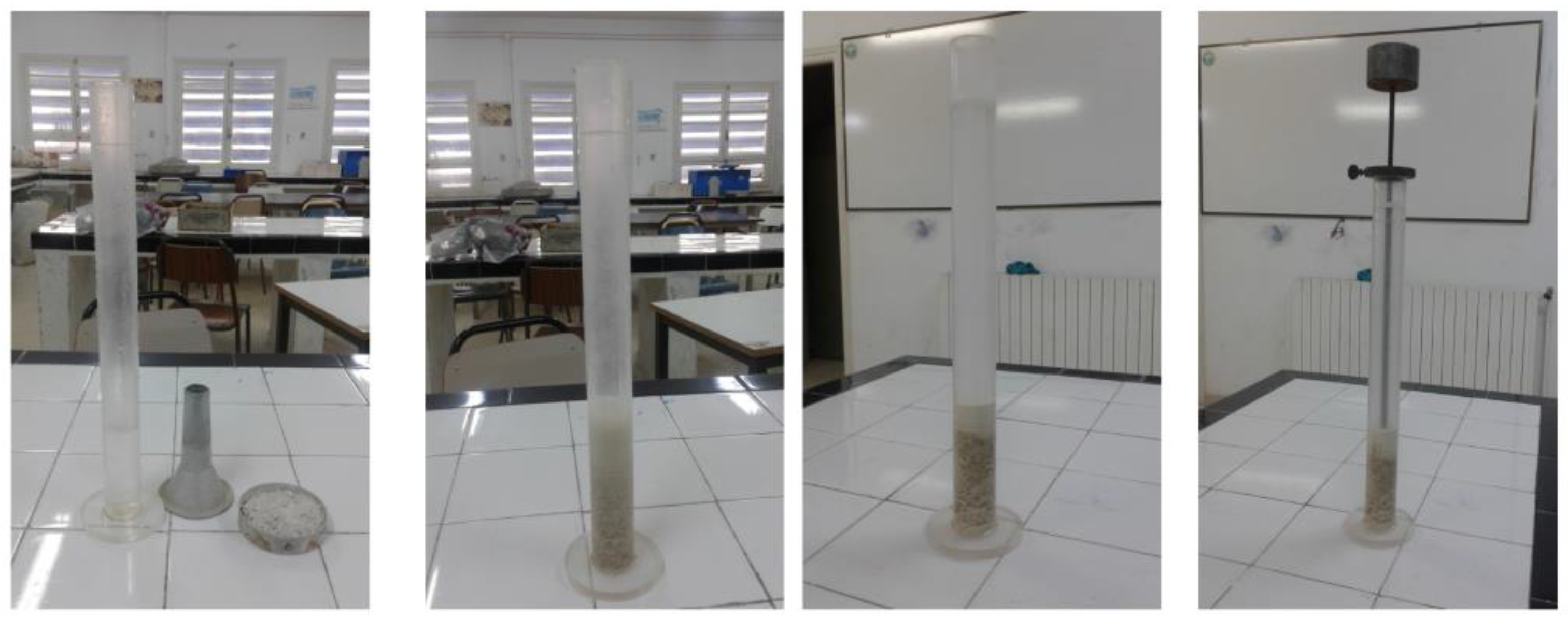

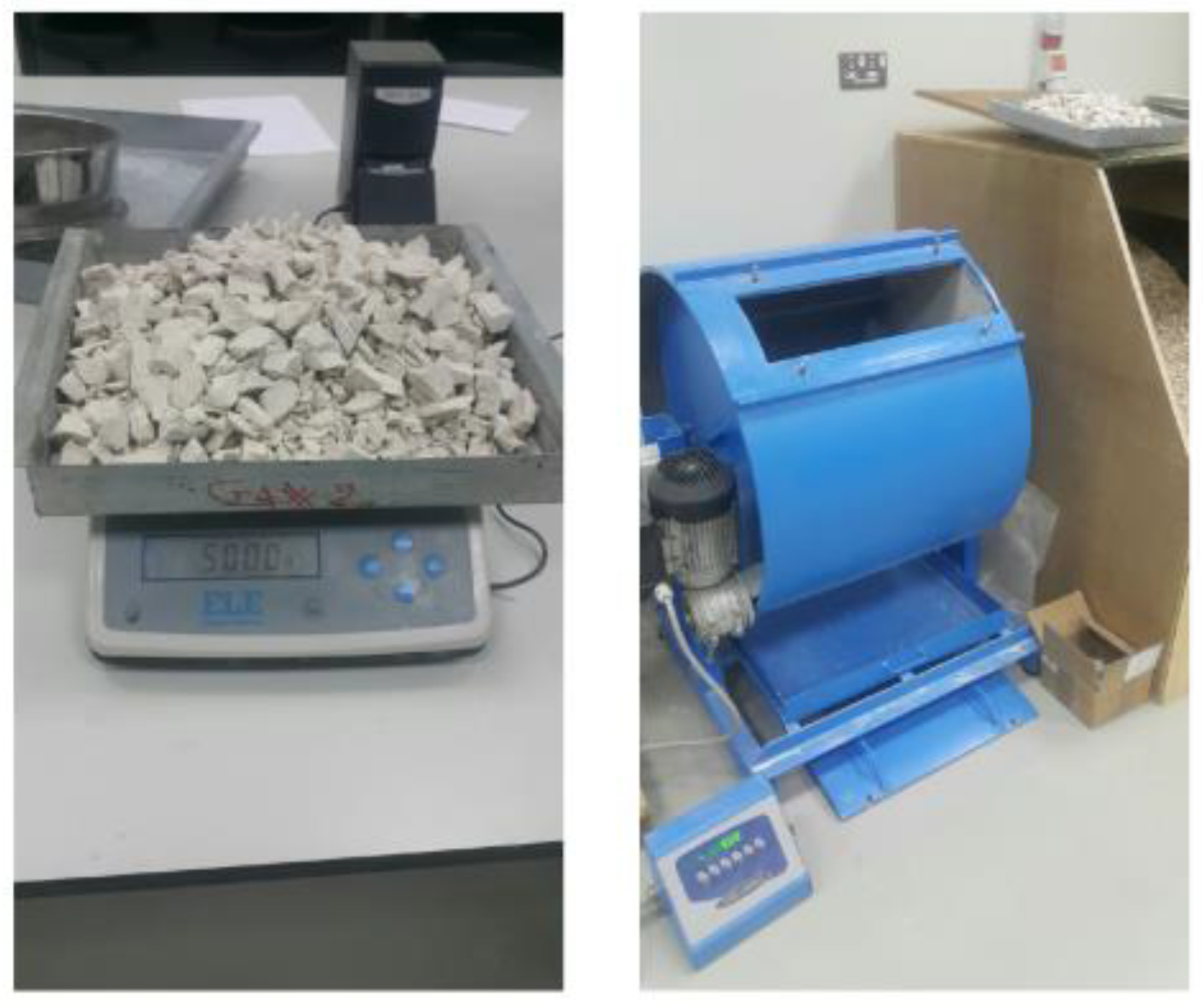

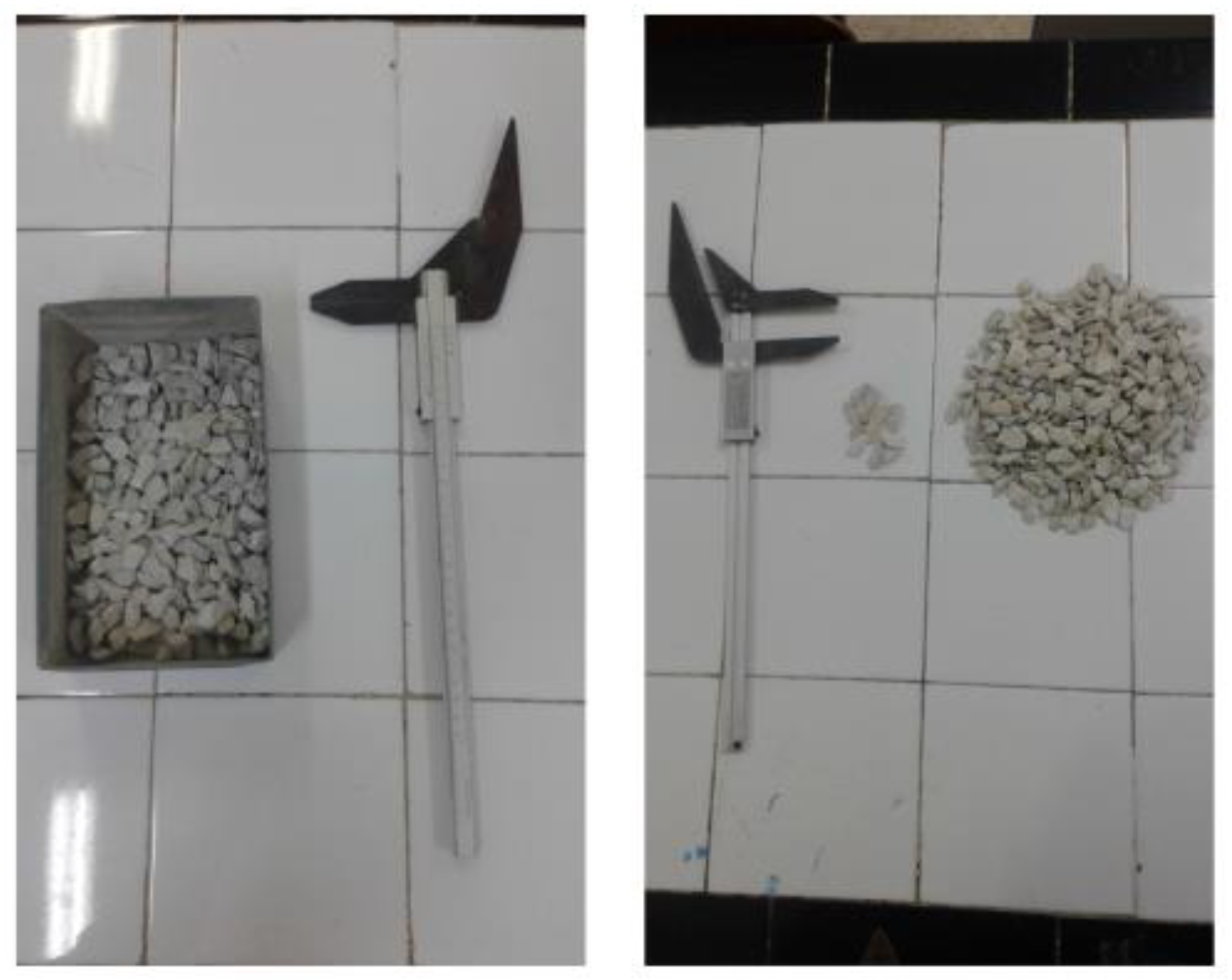
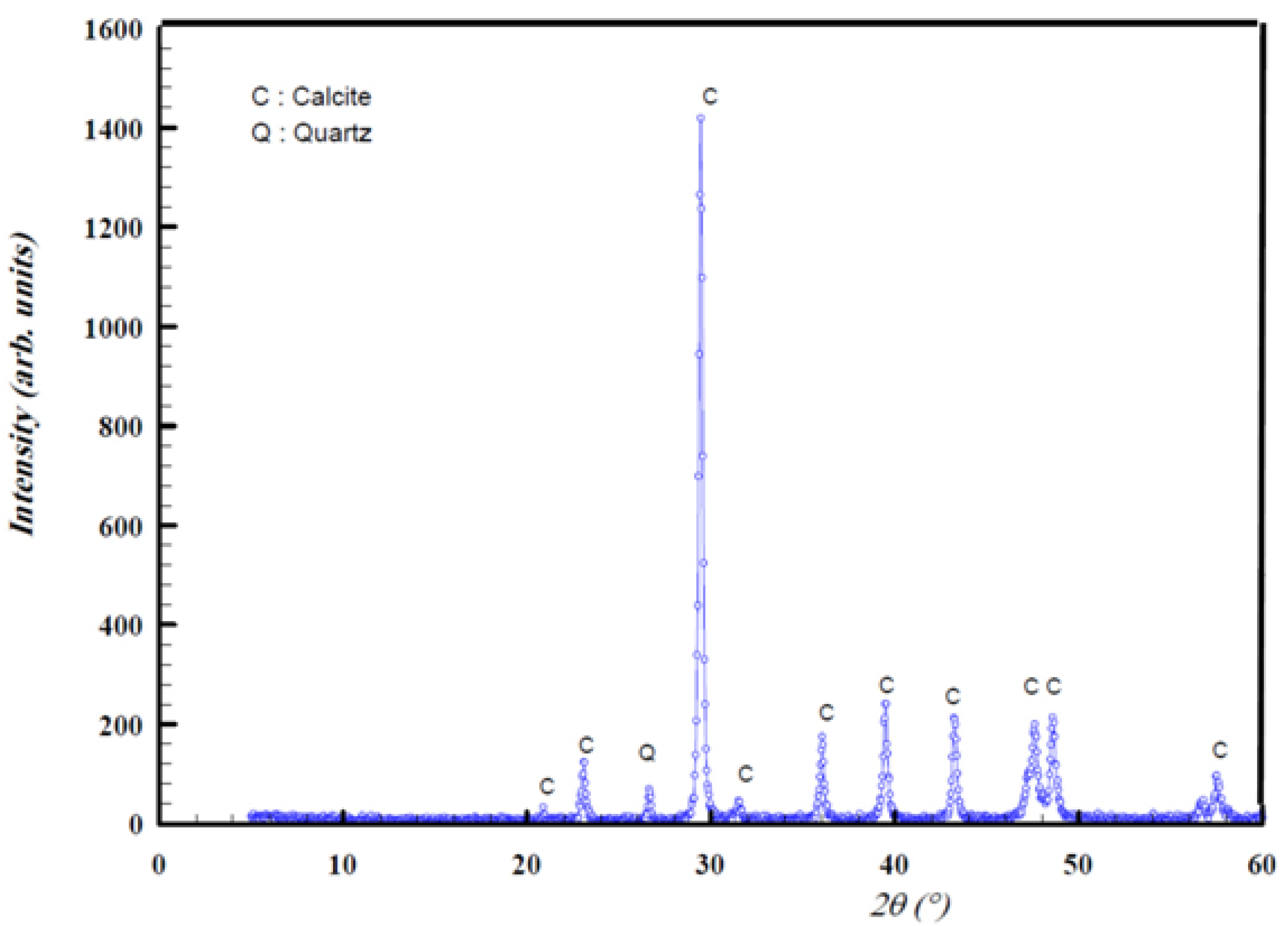
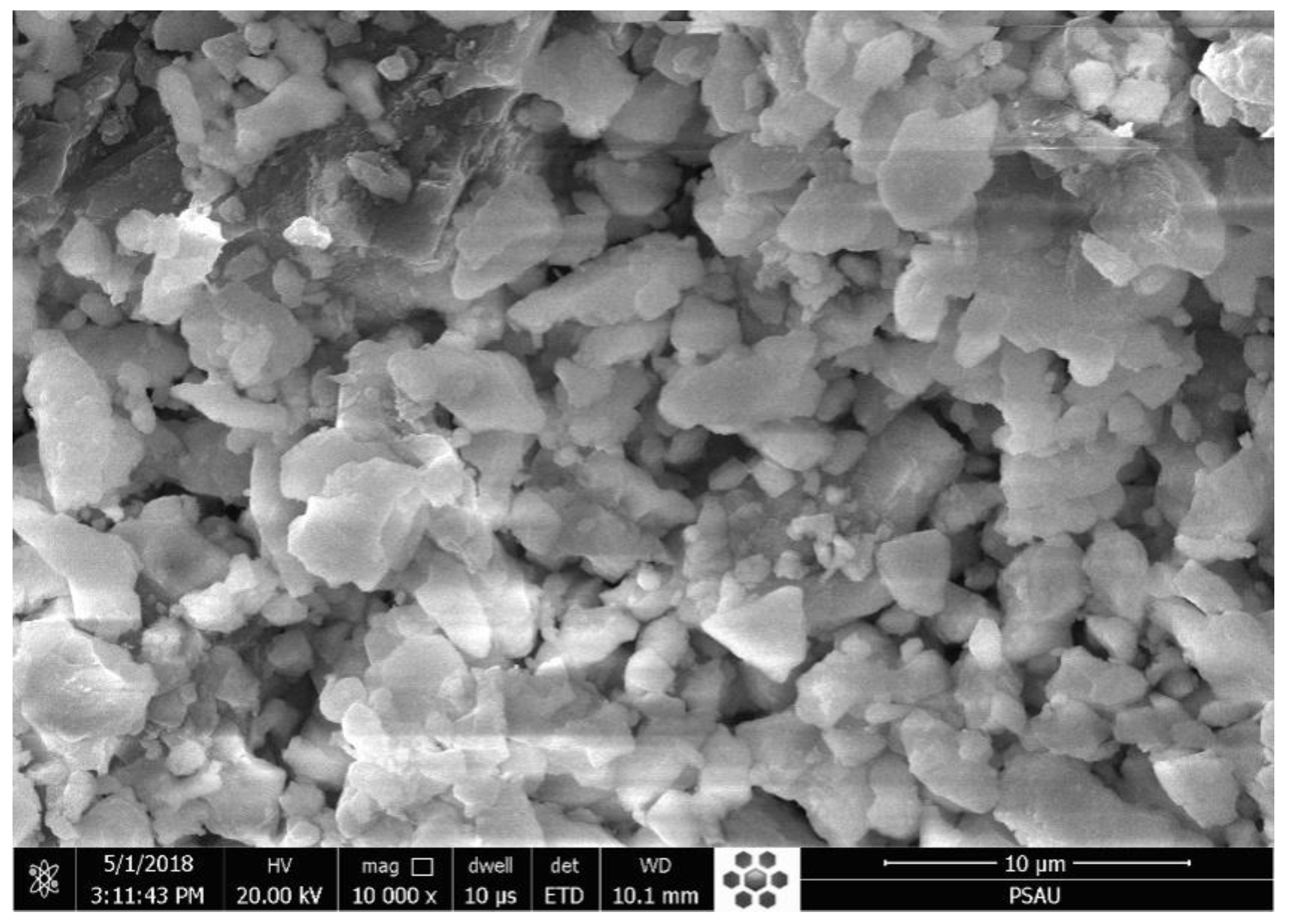

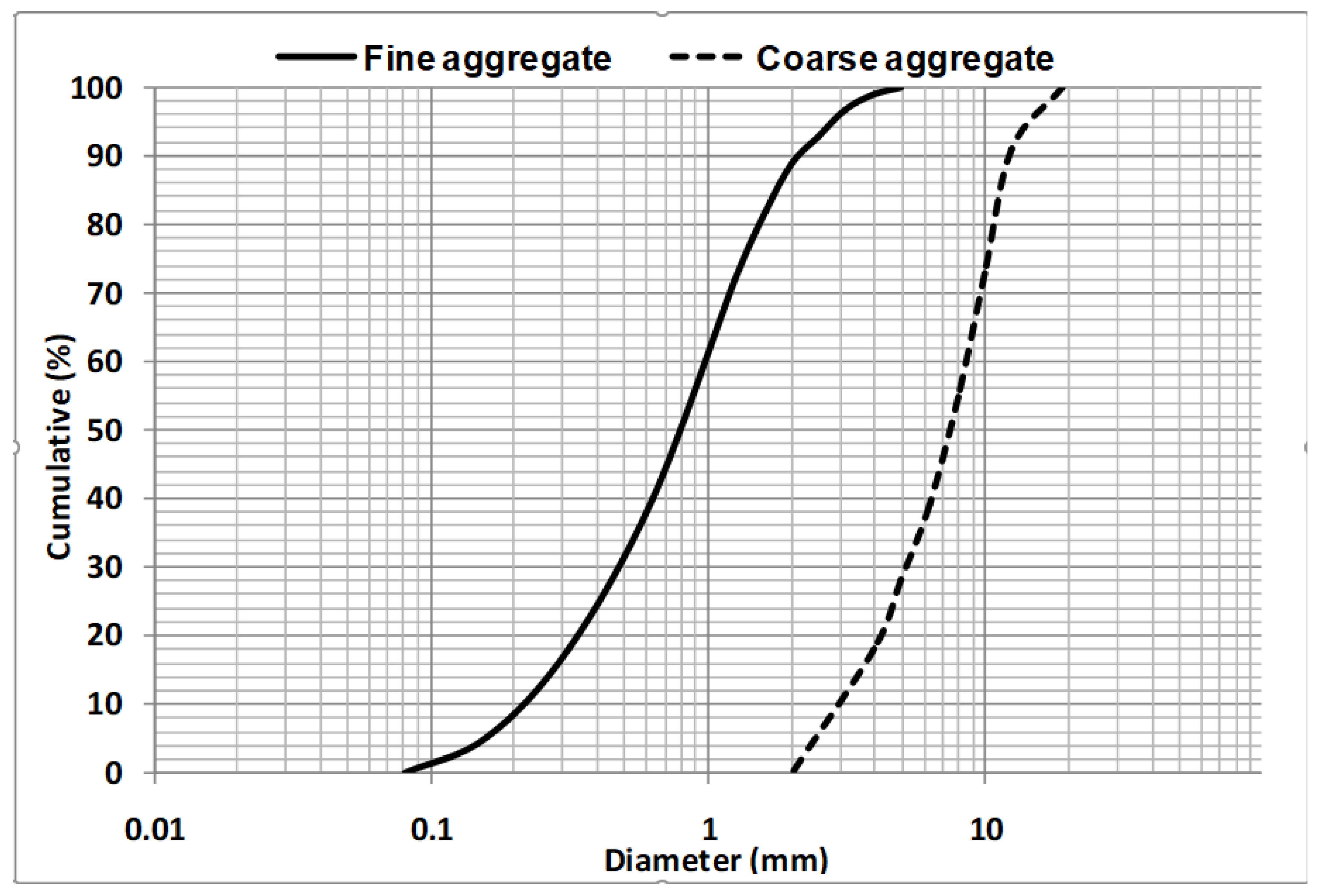
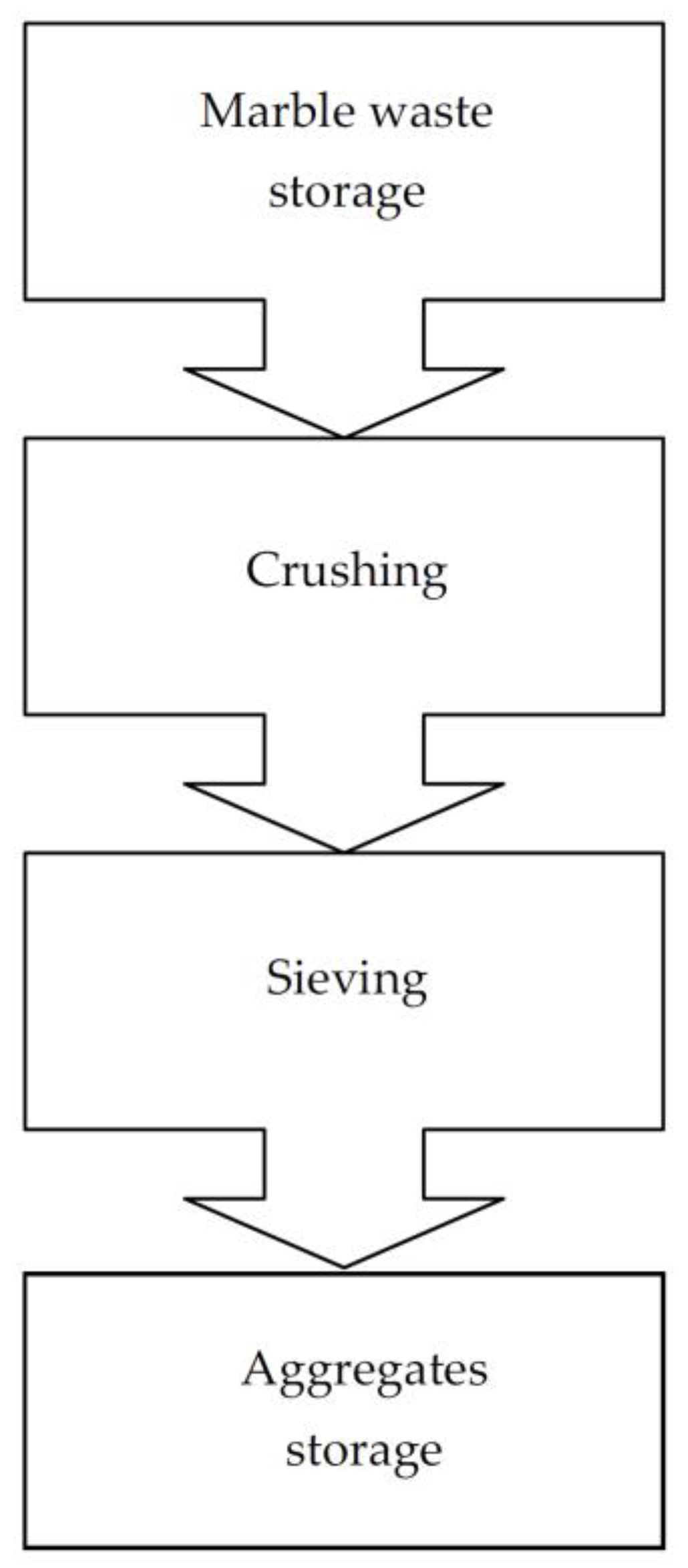
| Component | CaCO3 | LOI | CaO | MgO | SiO2 | Fe2O3 | Al2O3 | MgCO3 | Sulphur Trioxide (SO3) | Moisture |
|---|---|---|---|---|---|---|---|---|---|---|
| Percentage(%) | 95.21 | 42.07 | 53.14 | 0.44 | 2.53 | 0.35 | 0.25 | 1.18 | 0.02 | 0.02 |
| Parameters | Fine Aggregate | Coarse Aggregate | Recommended Values [2] |
|---|---|---|---|
| D10 | 0.24 | 3 | – |
| D30 | 0.5 | 6 | – |
| D60 | 0.95 | 8.5 | – |
| Coefficient of uniformity “Cu” | 3.96 | 2.83 | Cu < 2 |
| Coefficient of curvature “Cc” | 1.09 | 1.411 | 1 < Cc < 3 |
| Standard | Fine Aggregate | Coarse Aggregate | Recommended Values [2] | |
|---|---|---|---|---|
| Bulk density (g/cm3) | NF EN 1097-7 | 1.436 | 1.385 | 1.300–1.500 |
| Specific density (g/cm3) | 2.758 | 2.618 | 2.600–2.900 | |
| Absorption (%) | – | 1.36 | <2 | |
| Finesse modulus: FM | – | 1.85 | – | <3.1 |
| Equivalent of sand: ES (%) | NF EN 933-8 | 82 | – | >80 |
| Los Angeles: LA (%) | NF EN1097-2 | – | 22 | <30 |
| Micro Deval: MDE (%) | NF EN 1097-1 | – | 18 | <30 |
| Flakiness Index: FI (%) | NF EN 933-3 | – | 11 | <30 |
| Elongation Index: EI (%) | NF EN 933-4 | – | 3 | <35 |
Publisher’s Note: MDPI stays neutral with regard to jurisdictional claims in published maps and institutional affiliations. |
© 2022 by the authors. Licensee MDPI, Basel, Switzerland. This article is an open access article distributed under the terms and conditions of the Creative Commons Attribution (CC BY) license (https://creativecommons.org/licenses/by/4.0/).
Share and Cite
Benjeddou, O.; Mashaan, N. Experimental Study of the Usability of Recycling Marble Waste as Aggregate for Road Construction. Sustainability 2022, 14, 3195. https://doi.org/10.3390/su14063195
Benjeddou O, Mashaan N. Experimental Study of the Usability of Recycling Marble Waste as Aggregate for Road Construction. Sustainability. 2022; 14(6):3195. https://doi.org/10.3390/su14063195
Chicago/Turabian StyleBenjeddou, Omrane, and Nuha Mashaan. 2022. "Experimental Study of the Usability of Recycling Marble Waste as Aggregate for Road Construction" Sustainability 14, no. 6: 3195. https://doi.org/10.3390/su14063195
APA StyleBenjeddou, O., & Mashaan, N. (2022). Experimental Study of the Usability of Recycling Marble Waste as Aggregate for Road Construction. Sustainability, 14(6), 3195. https://doi.org/10.3390/su14063195







